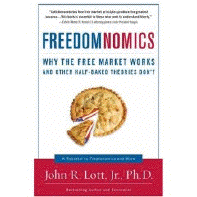
Freedomnomics
How bad is the economy? With a record percentage of the unemployed out of a job for more than six months, the media and politicians are claiming that the economy is in crisis. Politicians are again rushing to keep extended unemployment insurance benefits in place. The only serious debate among politicians was over how the benefits should be financed: should the program be paid for with spending cuts or tax increases or should we add to the deficit to cover the expense. And the Democratically-controlled Senate has passed the extension on Thursday by borrowing more money. President Obama signed it today.
Take the Los Angeles Times' concern: "Never since the Great Depression has the U.S. labor market seen anything like it. The previous high in long-term unemployment was 26% in June 1983, just after the deep downturn of the early '80s. The 44% rate this year translates into more than 6.5 million people." Senate Majority Leader Harry Reid claimed: "To [Republicans], it doesn't matter than these people lost their jobs through no fault of their own -- or that they're desperate to find a new full-time job -- or that this is an emergency not only for their families, but for our country." Even the person leading the "other side" of the debate, Senator Tom Coburn (R-Okla.) said: "itís the right issue for the country and we ought to be about paying for the things we do."
The unemployed are eligible for up to either 95 or 99 weeks of unemployment insurance benefits depending on whether the unemployment rate in their state is over 8.5 percent. The benefits are unprecedented. That is almost two whole years, compare that to the maximum of 26 weeks that the unemployed were eligible for as recently as June 2008. To get some perspective about long the benefits last, from 1954 to 2007 the national average maximum duration for unemployment insurance ranged from a low of 22.8 weeks in 1954 to a high of 27.2 weeks during most of the 1970s (click here for Figure 1).
But that is not all. Besides the length of benefits, the level of benefits is also unprecedented -- the unemployed now get more money each week that they are unemployed and get their health insurance paid for.
While most discussions assume that the long time that people are unemployed shows the need for longer benefits, there is another possibility: the unprecedented benefits are the cause, not the cure, for the current long term unemployment. The more you subsidize something, the more you get of it. In this case, people only get these unemployment benefits as long as they are unemployed. It is well known that most of the unemployed wait until their benefits are about to run out before they take a job. About a third of workers receiving unemployment insurance find work right after their benefits run out. This happens whether unemployment is high or low.
Larger benefits also encourage some people, who may be unhappy with their jobs, to become unemployed while they look for something better. Others will be a little more reluctant to take a new job when they are offered it.
Figure 2 (click here) shows monthly data from January 2007 to March 2010. What is clear is that the percentage of the unemployed who are unemployed for more than six months only increases after the length of the unemployment benefits is increased. Figure 3 click here) shows the same pattern for the median number of weeks that people are unemployed.
Being unemployed for a long period of time is surely horrible. But we also need to understand that if the unemployment benefits were as high during past recessions as they are now, past unemployment rates would probably be much worse than they are right now. The long-term unemployment during this recession is only uniquely bad because of government policies.
John R. Lott Jr. is a FOXNews.com contributor. He is an economist and the author of "More Guns, Less Crime (University of Chicago Press, 2010), the third edition will be published in May.".

Article published Friday, April 16, 2010, at Fox News.
The Real Reason for Our High Unemployment Numbers
Unprecedented benefits are the cause, not the cure, for the current long term unemployment.
By John R. Lott, Jr.
|
Home
Johnlott.org
(description of book, downloadable data sets, and discussions of previous controversies)
Academic papers:
Social Science Research Network
Book Reviews:
For a list of book reviews on The Bias Against Guns, click here.
---------------------------------
Posts by topic
Fraudulent website pretending to be run by me
The Merced Pitchfork Killings and Vin Suprynowicz's quote
Mother Jones article
Links
Interview with National Review Online
Lyonette Louis-Jacques's page on Firearms Regulation Worldwide
The End of Myth: An Interview with Dr. John Lott
Some data not found at www.johnlott.org:
Updated Media Analysis of Appalachian Law School Attack
Since the first news search was done additional news stories have been
added to Nexis:
There are thus now 218 unique stories, and a total of 294 stories counting
duplicates (the stories in yellow were duplicates): Excel file for
general overview and specific stories. Explicit mentions of defensive gun use
increase from 2 to 3 now.
Journal of Legal Studies paper on spoiled ballots during the 2000 Presidential Election
|